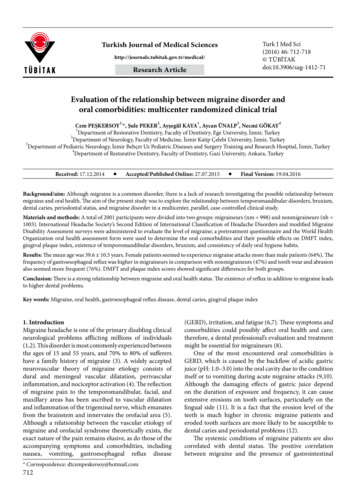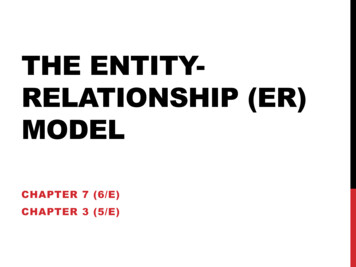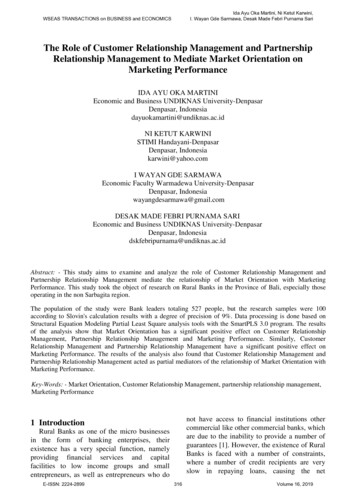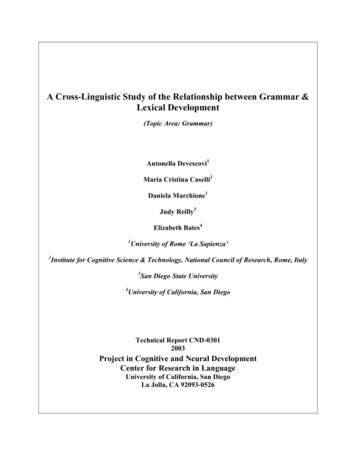
Transcription
Turkish Journal of Medical SciencesTurk J Med Sci(2016) 46: 712-718 bitak.gov.tr/medical/Research ArticleEvaluation of the relationship between migraine disorder andoral comorbidities: multicenter randomized clinical trial1,2134Cem PEŞKERSOY *, Şule PEKER , Ayşegül KAYA , Aycan ÜNALP , Necmi GÖKAY1Department of Restorative Dentistry, Faculty of Dentistry, Ege University, İzmir, Turkey2Department of Neurology, Faculty of Medicine, İzmir Katip Çelebi University, İzmir, Turkey3Department of Pediatric Neurology, İzmir Behçet Uz Pediatric Diseases and Surgery Training and Research Hospital, İzmir, Turkey4Department of Restorative Dentistry, Faculty of Dentistry, Gazi University, Ankara, TurkeyReceived: 17.12.2014Accepted/Published Online: 27.07.2015Final Version: 19.04.2016Background/aim: Although migraine is a common disorder, there is a lack of research investigating the possible relationship betweenmigraine and oral health. The aim of the present study was to explore the relationship between temporomandibular disorders, bruxism,dental caries, periodontal status, and migraine disorder in a multicenter, parallel, case-controlled clinical study.Materials and methods: A total of 2001 participants were divided into two groups: migraineurs (nm 998) and nonmigraineurs (nh 1003). International Headache Society’s Second Edition of International Classification of Headache Disorders and modified MigraineDisability Assessment surveys were administered to evaluate the level of migraine; a pretreatment questionnaire and the World HealthOrganization oral health assessment form were used to determine the oral comorbidities and their possible effects on DMFT index,gingival plaque index, existence of temporomandibular disorders, bruxism, and consistency of daily oral hygiene habits.Results: The mean age was 39.6 10.5 years. Female patients seemed to experience migraine attacks more than male patients (64%). Thefrequency of gastroesophageal reflux was higher in migraineurs in comparison with nonmigraineurs (47%) and tooth wear and abrasionalso seemed more frequent (76%). DMFT and plaque index scores showed significant differences for both groups.Conclusion: There is a strong relationship between migraine and oral health status. The existence of reflux in addition to migraine leadsto higher dental problems.Key words: Migraine, oral health, gastroesophageal reflux disease, dental caries, gingival plaque index1. IntroductionMigraine headache is one of the primary disabling clinicalneurological problems afflicting millions of individuals(1,2). This disorder is most commonly experienced betweenthe ages of 15 and 55 years, and 70% to 80% of sufferershave a family history of migraine (3). A widely acceptedneurovascular theory of migraine etiology consists ofdural and meningeal vascular dilatation, perivascularinflammation, and nociceptor activation (4). The reflectionof migraine pain to the temporomandibular, facial, andmaxillary areas has been ascribed to vascular dilatationand inflammation of the trigeminal nerve, which emanatesfrom the brainstem and innervates the orofacial area (5).Although a relationship between the vascular etiology ofmigraine and orofacial syndrome theoretically exists, theexact nature of the pain remains elusive, as do those of theaccompanying symptoms and comorbidities, includingnausea, vomiting, gastroesophageal reflux disease* Correspondence: dtcempeskersoy@hotmail.com712(GERD), irritation, and fatigue (6,7). These symptoms andcomorbidities could possibly affect oral health and care;therefore, a dental professional’s evaluation and treatmentmight be essential for migraineurs (8).One of the most encountered oral comorbidities isGERD, which is caused by the backflow of acidic gastricjuice (pH: 1.0–3.0) into the oral cavity due to the conditionitself or to vomiting during acute migraine attacks (9,10).Although the damaging effects of gastric juice dependon the duration of exposure and frequency, it can causeextensive erosions on tooth surfaces, particularly on thelingual side (11). It is a fact that the erosion level of theteeth is much higher in chronic migraine patients anderoded tooth surfaces are more likely to be susceptible todental caries and periodontal problems (12).The systemic conditions of migraine patients are alsocorrelated with dental status. The positive correlationbetween migraine and the presence of gastrointestinal
PEŞKERSOY et al. / Turk J Med Scidisorders (GIDs) has previously been established in manyclinical and epidemiological studies (13). The clinicalfeatures of GIDs in migraine patients are most commonlycharacterized by the effects of acidic gastric juice onmandibular teeth (14). Several studies have demonstratedpossible relationship between cardiovascular diseases(CVDs) and migraine (4,15,16). The functional significanceof CVDs in migraine patients is that poor oral hygienecould be a predisposing factor for infective endocarditiscaused by streptococcal bacteria (17).Temporomandibular disorder (TMD) is a collectiveterm that encompasses a number of clinical problems thatinvolve the masticatory muscles, the temporomandibularjoint (TMJ), and associated structures (18). The mostcommon symptom of TMD is pain, usually located fromthe temporomandibular region to the retromandibulararea through the masticatory muscles, and usuallyconfused with chronic headaches reflected to these areas(19). Although not as well characterized as the prevalenceof common headache syndromes, the prevalence of TMDin migraineurs has ranged from 22% to 52% (20).According to epidemiological studies of adultpopulations, 50% to 75% of migraineurs have at leastone sign of comorbidity, and nearly 35% have at least onesymptom of TMD (18). The aim of the present study wasto determine the relationships among oral hygiene, dentalstatus, accompanying systemic conditions, and chronicmigraine status in a case-control clinical study, to prove thehypothesis that there is a relationship between migraineand oral health and care.2. Materials and methods2.1. Study designTwo thousand six hundred and eighty one patients(between 18 and 60 years old and of both sexes) whopresented at the neurology clinics of Izmir Ataturk Trainingand Education Hospital and Ege University and Behcet UzTraining Hospital were invited to participate in this study.A case-control, observational, and multicenter study wasdesigned; the study was approved by the Ethics Committeeof Ege University (reg no: 11-10.1/9) and written consentwas obtained from all participants. Patients were examinedby two neurologists who have experience in the headachefield and clinical diagnosis of the neurologist was used asthe gold standard. The final diagnosis was made accordingto the International Headache Society’s Second Editionof International Classification of Headache Disorders toevaluate the existence, level, and effects of migraine ondaily life (21,22). Prior to the study, Migraine DisabilityAssessment tests, modified for the present study (MS-Qand MIDAS), were also administered to each participantwho was under medication for migraine to determinethe systemic, socioeconomic, educational, and habitualstatuses and the frequency of comorbid factors affectingthe patient’s quality of life (Figure) (2,21,23). Some of thecomorbid factors such as photophobia, motion sickness,and dizziness were also transferred directly from hospitalrecords to the patients’ charts. Both migraine patients andnonmigraineurs were informed about the study design,and the patients who accepted the terms were includedin the volunteer pool. The postevaluation stage involvedthe creation of two groups: Group 1 consisted of patientsdiagnosed with migraine (nm 998) and Group 2 consistedof nonmigraineurs as a control group (nh 1003),according to the block and unregistered randomizationtype. Therefore, all of the participants in both groups werechosen from similar socioeconomic levels; also, they wereuniversity graduates, nonsmokers, and nondrinkers andhad average body mass indices (BMI: 25–29). Participantswho were unable to complete the questionnaires, smokers,alcohol users, and patients who did not approve of theterms were excluded (n 40). Patients who were unableto complete oral examinations (9), questionnaires (3.4%),and patients with additional psychological problems(7.1%) that could affect the study results were classified asmissing data and also excluded (n 189).Each new patient with/without migraine was offeredan evaluation by two different restorative dentistryspecialists from Ege University at the same health centerfacility on the same day. To establish a double-blind study,both of the examiners were unaware of which group wasbeing examined, and the interexaminer reliability wasassessed with correlation coefficients (ICCs), using mixedeffects regression models. The evaluation consisted of theapplication of a questionnaire (pretreatment form) and anoral examination to evaluate the dental and periodontalstatus (Figure). The questionnaire had three categories toevaluate oral hygiene habits, previous dental experiences,and common problems/requests in correlation withmigraine and subtypes. The oral examinations wereperformed using the World Health Organization oralhealth assessment form (Geneva, 2009) to record previousdental treatments, periodontal status, bruxism, dentalcaries (ICDAS criteria), and TMD. Erosion and abrasionswere categorized according to the Bartlett and Shahclassification (1).2.2. Statistical analysisAll of the data acquired from the questionnaires and oralassessment forms, such as the patients’ sociodemographicand clinical properties, age, sex, and family history ofmigraine were descriptively analyzed; means, standarddeviations, and 95% confidence intervals were calculatedfor quantitative variables and frequencies for qualitativevariables. Adjustment was made for individual’s sex,age, systemic conditions, existence of comorbidities, and713
PEŞKERSOY et al. / Turk J Med SciFigure. Modified MS-Q and MIDAS surveys to determine the level of migraine, systemic, socioeconomic, educational, and habitualstatuses of the patients and the frequency of accompanying comorbidities.overall dental health and care status. All analyses wereweighted to account for the individual survey sampledesigns. Analyses considered that observations within eachcluster of survey were not independent from each other.The estimation of the sample size was performed with apower analysis test using SPSS software, version 17.0. Theevaluation of migraine distribution by age and sex wasperformed by the chi-square test with a significance levelof 0.05. The independent t-test was used to compare thesystemic conditions between the patients with migraineand nonmigraineurs. Pearson’s correlation test was used toassess the association between oral healthcare and DMFT/GPI scores and potential confounders.3. ResultsThe data collected from 2001 participants wereanalyzed and revealed nonnegligible differences. Of theparticipants, 36% were male (n 720) and 64% werefemale (n 1281). The sex distribution in both groupswas similar to standardize the research (M/F: 34/66 vs.38/62). The mean age of the participants was 39.57 10.49 years old, ranging from 21 to 60 years old. Female714participants suffered from migraine significantly morethan male participants (P 0.05). Systemic diseases anddisorders such as cardiovascular and gastrointestinalsystem diseases, metabolic disorders, and systemic lupuserythematosus, showed no significant differences amongthe participants (Table 1) (P 0.05). While photophobiawas the most common accompanying symptom,phonophobia, nausea, and gastroesophageal reflux werealso found to be high. The other accompanying factorsshown in Table 2 in migraineurs were statisticallydifferent from nonmigraineurs (P 0.05).The frequency of GERD was 42% in the migrainepatients and 18% in the control group (P 0.05).Gastrointestinal problems such as gastritis and ulcers weremuch more common in nonmigraineurs (12%, P 0.05)(Table 1). The rate of migraine patients who suffered frombruxism and TMD were relatively high in comparisonwith the control group (49%, P 0.05), while correlationanalysis showed that the frequency of erosion andabrasions was positively correlated with the existence ofbruxism (P 0.05). Details, including systemic conditions,are also shown in Table 1.
PEŞKERSOY et al. / Turk J Med SciTable 1. Evaluation of patients with migraine and nonmigraineurs for systemic diseases.MaleFemaleMaleFemaleGroup 1 vs.Group 2 #Hypertension (HTN)70161621480.866Cardiac dysrhythmia215930320.582Chronic obstructive pulmonary disease eal reflux (GERD)175248821010.000*Gastritis-gastric ulcer312922360.348Diabetes mellitus (DM)3010732740.509Thyroid emic conditionsCardiovascular diseasesRespiratory diseasesGastrointestinal system diseasesEndocrine-metabolic diseasesAutoimmune diseasesSystemic lupus (SLE)Nephrological diseasesGlomerulonephritis*: significant difference.#: Group 1: Migraine patients; Group 2: Nonmigraineurs.Table 2. The subtypes of migraine in relation to accompanying symptoms.Accompanying symptoms of migraine in correlation with subtypesStatusAbdominalRetinalSpecific migrainemigrainewith auramigrainemigrainewithout aura(%)Phonophobia4 (100%)2 (40%)6 (33%)271 (86%)1 (25%)1 (33%)409 (63%)694 (70%)Phonophobia3 (75%)1 (20%)1 (5%)216 (69%)––315 (49%)536 (54%)Dizziness3 (75%)2 (40%)–82 (26%)1 (25%)–248 (38%)376 (37%)Motion Sickness4 (100%)2 (40%)1 (5%)168 (53%)––87 (13%)262 (26%)Nausea1 (25%)5 (100%)–238 (76%)––245 (38%)489 (49%)Vomiting–5 (100%)–199 (63%)–191 (29%)394 (39%)Total cases45183154649998 (100%)PhotophobiaOral hygiene status was similar in both groups (P 0.05). Although daily tooth brushing (98% vs. 96%, P 0.05) and dental flossing (39% vs. 40%, P 0.05) weresimilar, as might be expected, regular dental visits wereslightly increased to 40%, while dentophobia was increasedto 42% in migraine patients, which was significant (P 0.05). Tooth wear and abrasion seemed more frequentin patients with migraine (76%, P 0.05). DMFT scores(mean 3.79 vs. 2.71, P 0.05) and gingival plaque indexscores (mean 1.64 vs. 1.23, P 0.05) showed significantdifferences between the groups (Table 3).The participants’ statements revealed that during acutemigraine attacks dental care was disrupted for at least 24 h(Table 3). Of the participants, 64% experienced limitationsin oral hygiene habits, whereas 2% of participants stoppedtooth brushing to avoid triggering pain (P 0.05).715
PEŞKERSOY et al. / Turk J Med SciTable 3. Oral health and care status amongst patients with migraine.Group 1Oral health and dental statusGroup 2P-valueMaleFemaleMaleFemaleToothbrush use3306523665940.791Dental floss use1341421111950.921Dental visits2013093173340.042*Dental anxiety and phobia89171672220.037*Bruxism1213611431500.006*TME disorders1522401182320.045*Tooth wear and *DMFT index score ᶧ3.83.72.82.60.000*Gingival plaque index ᶧ1.71.61.41.10.000*Oral health careOral dental statusOral indexesᶧ: Overall mean values for the patients.*: Significant difference.4. DiscussionThe incidence of migraine has been reported to bethe highest among middle-aged females (1–3,21,24).Recent studies reported that the prevalence of migrainewithout aura is higher than migraine with aura, and themore frequent subtype of migraine encountered is ofthe tension or chronic migraine subtype (25,26). Thefindings of the present study corroborated the findingsof the above mentioned recent studies where it wasobserved that subtypes of migraine are very rare and donot affect the data. Previous research has addressed thepossible associations between migraine and hypertension,hemorrhagic stroke, and CVDs (15,27). For example,Ylöstalo et al. (28) demonstrated that relatively low oralhygiene status among migraine patients was a majorunderlying factor of infective endocarditis. Our study alsorevealed a positive relationship between the existence ofmigraine and oral and dental status. To our knowledge,our study is the first to look at this relationship usingcorrelation analyses, investigating the possible effects ofcomorbid conditions present to oral hygiene. Althoughmost studies have suggested that migraine patients aremore likely to be susceptible to hypertension and to haveimpaired insulin sensitivity, autoimmune diseases, andseveral comorbidities related to these diseases, it shouldbe investigated whether oral symptoms are the cause716or consequence of migraine (8,18,29,30). None of thesystemic conditions in migraineurs differed from those ofnonmigraineurs in the present study except for GERD. Thisdifference could be explained by disturbances in migrainepatients of the parasympathetic branch of the autonomicnervous system, which controls the gastrointestinal reflexes(31). In migraineurs, nausea and bulimia, in addition toGERD, are well-known accompanying symptoms thataffect the oral health (7). Volitional vomiting can provideshort-term relief of pain, but consistent vomiting can leadto serious complications such as tooth erosion (9,32,33).The abrasion, thus caused, could explain the low caries riskbut high tooth wear and high fracture incidences in dentalrestorations (8,34). The results of our study show that thepresence of migraine was associated with an increasederosion and abrasion intensity, which leads to dental tissuesusceptibility to dental caries.TMDs have frequently been associated with bothhead and jaw pain; therefore, it is easy to confuse TMDswith acute migraine attacks (18,35). The pain is usuallylocalized in the temporomandibular region, and thetype, frequency, and predisposing factors of this pain arereferred to TMDs (36). Although not all migraine patientssuffer from TMDs, the relationship between malocclusionand migraine cannot be overestimated. It is, however,unclear whether the cause of malocclusion is TMD or
PEŞKERSOY et al. / Turk J Med Sciskeletal problems (37). In addition, it is not known whetherTMD is one of the main causes of migraine or the effectof neuropathic muscle contraction during acute migraineattacks (27,38). In contrast, some parafunctional habitssuch as bruxism and masseter hypertrophy are secondaryoral consequences of migraine attacks originating fromTMDs, resulting in extensive tooth wear and abfraction,which affects oral health dramatically (33). According toour findings, bruxism caused by TMD resulted in toothwear on occlusal surfaces and caused malocclusion, whichhas been associated with migraine attacks; it initiatednon-TMD-related (masseter muscle-related) bruxism,initiating a vicious cycle. This deduction is consistent withthe study by Pistoia et al. (39). In addition, correlationanalysis proved that migraineurs who suffered from TMDsalso had tooth wear, but no positive correlation was foundunless accompanied by bruxism. However, an associationbetween migraine and TMD has been previously observed(36), and our results may support the notion that DMFTand periodontal status are most likely to stem fromcomorbid factors such as GERD and vomiting, which leadto extensive dental hard tissue loss.Pearson’s analysis also showed a strong correlationbetween migraine and DMFT and plaque index scores, asstated in previous studies. This could be the result of eithersusceptible tooth surfaces caused by erosion and abrasionor a significant increase in dental anxiety and phobias,which can lead to decreased regular dental visits (40,41).The importance of migraine headaches in thepopulation lies in its disability potential (23). Intermittentdental care leads to significant changes in oral hygiene;hence, dental and periodontal tissues can suffer. Inaddition, the medication used for migraine attacks canexacerbate these conditions (41). Although there havebeen many previous studies showing the relationshipbetween migraine and oral health, few of these studies havementioned the possible effects of migraine attacks on dailyoral health care (42). Along with the discomfort causedby the headache, the results of our study showed majoreffects of interruption of daily dental care routines. Ourresearch could be useful because it offers the opportunityto evaluate the possible effects of migraine on oral hygieneand daily oral care.According to its intensity and dispersion, pain isreferred from the TMJ to the maxillary and mandibularposterior areas, as well as the teeth in those areas (43).According to our findings, the evidence corroboratedour hypothesis of a relationship between migraine andoral health care, particularly the erosions and toothabrasions caused by the stress of upcoming migraineattacks, supporting the results of the study conducted byNixdorf et al. (44). Dental plaque can easily accumulate oneroded and abraded tooth surfaces, which can cause dentalcaries and gingivitis. Within the limitations of this crosssectional study, further investigations and evaluationsmust be performed to establish causal relationshipsbetween migraine and oral comorbidities.In conclusion, patients with migraine headaches whoconsulted dental professionals were usually misdiagnosedand received unnecessary treatments. Most dentalclinicians are unfamiliar with this headache disorder andits associated oral health problems. In addition, most ofthe patients are unaware of their oral health conditionbecause of chronic migraine disease. The cervical erosionscaused by GERD and the occlusal tooth wear caused bybruxism are the main problems that must be managedconcomitantly to achieve improved treatment outcomes.References1.Robbins MS, Lipton RB. The epidemiology of primaryheadache disorders. Semin Neurol 2010; 30: 107-119.7.Wang SJ, Chen PK. Comorbidities of migraine. Front Neurol2010; 1: 16-21.2.Zarifoglu M, Siva A, Hayran O. An epidemiological study ofheadache in Turkey: a nationwide survey. Neurology 1998; 50:80-85.8.Melis M, Secci S. Migraine with aura and dental occlusion. JMass Dent Soc 2006; 54: 28-30.3.Pinto A, Parastatidis MA, Balasubramaniam R. Headache inchildren and adolescents. J Can Dent Assoc 2009; 75: 14881519.9.Guaré RO, Ferreira MC. Dental erosion and salivary flow ratein cerebral palsy individuals with gastroesophageal reflux. JOral Pathol Med 2011; 10: 1111-1120.4.Schürks M, Rist PM, Bigal ME. Migraine and cardiovasculardisease: systematic review and meta-analysis. BMJ 2009; 27:339-347.10.Ranjitkar S, Kaidonis JA, Smales RJ. Gastroesophageal refluxdisease and tooth erosion. Int J Dent 2012; 85: 1-10.11.Bartlett DW, Shah P. A critical review of non-carious cervical(wear) lesions and the role of abfraction, erosion, and abrasion.J Dent Res 2006; 85: 306-312.12.Stich H. Erosion. Clinical aspects--diagnosis--risk factors-prevention--therapy. Schweiz Monatsschr Zahnmed 2005; 115:917-946 (article in French with an abstract in English).5.Tietjen GE. Migraine as a systemic vasculopathy. Cephalalgia2009; 29: 987-996.6.Scher AI, Bigal ME, Lipton RB. Comorbidity of migraine. CurrOpin Neurol 2005; 18: 305-10-17.717
PEŞKERSOY et al. / Turk J Med Sci29.Shoji Y. Cluster headache following dental treatment: a casereport. Journal of Oral Science 2011; 53: 125-127.30.Tjensvoll AB, Gøransson LG, Harboe E, Kvaløy JT, OmdalR. High headache-related disability in patients with systemiclupus erythematosus and primary Sjögren’s syndrome. Eur JNeurol 2014; 21: 1124-1130.31.Rezai A, Ansarinia M. Methods of treating medical conditionsby transvascular neuromodulation of the autonomic nervoussystem. US Patent Application 2005; 11/222,766.32.Gupta R, Bhatia MS. Comparison of clinical characteristicsof migraine and tension type headache. Indian Journal ofPsychiatry 2011; 53: 134-140.Teixeira AL Jr, Meira FC, Maia DP. Migraine headache inpatients with Sydenham’s chorea. Cephalalgia 2005; 25: 542544.33.Machado NAG, Fonseca RB. Dental wear caused by associationbetween bruxism and gastroesophageal reflux: a rehabilitationreport. J Appl Oral Sci 2007; 15: 327-336.18.Goncalves DA, Camparis CM, Speciali JG. Treatment ofcomorbid migraine and temporomandibular disorders: afactorial, double-blind, randomized, placebo-controlled study.J Orofac Pain 2013; 27: 325-335.34.Wan Nik WNN, Banerjee A, Moazzez R. Gastro-oesophagealreflux disease symptoms and tooth wear in patients withSjögren’s syndrome. Caries Res 2011; 45: 323-326.19.Glaros AG, Urban D, Locke J. Headache and temporomandibulardisorders: evidence for diagnostic and behavioral overlap.Cephalalgia 2007; 27: 542-549.35.Blumenfeld A, Bender SD, Glassman B. Bruxism,temporomandibular dysfunction, tension type headache, andmigraine: a comment. Headache 2011; 51: 1549-1558.20.Gesch D, Bernhardt O, Alte D. Prevalence of signs andsymptoms of temporomandibular disorders in a urban andrural German population: results of a population-based studyof health in Pomerania. Quintessence Int 2004; 35: 143-150.36.Silva AA Jr, Brandão KV, Faleiros BE. Temporo-mandibulardisorders are an important comorbidity of migraine and maybe clinically difficult to distinguish them from tension-typeheadache. Arq Neuro-psiquiat 2014; 72: 99-103.21.Goadsby PJ. Recent advances in the diagnosis and managementof migraine. BMJ 2006; 7: 25-29.37.Takeuchi M, Kato M, J Saruta J. Relationship between migraineand malocclusion. J Headache Pain 2013; 14: 136-138.22.Valade D. Chronic migraine. Rev Neurol 2013; 169: 419-426.38.23.Lainez MJ, Castillo J, Dominguez M. New uses of the MigraineScreen Questionnaire (MS-Q): validation in the Primary Caresetting and ability to detect hidden migraine. MS-Q in PrimaryCare. BMC Neurol 2010; 10: 39-46.Steele JG, Lamey PJ, Sharkey SW. Occlusal abnormalities,pericranial muscle and joint tenderness and tooth wear in agroup of migraine patients. J Oral Rehabil 1991; 18: 453-458.39.Pistoia F, Sacco S, Carolei A. Behavioral therapy for chronicmigraine. Curr Pain Headache R 2013; 17: 304-309.24.Liu J, Qin W. Gender-related differences in the dysfunctionalresting networks of migraine suffers. Plos One 2011; 6:10.1371-1378.40.Hugo FN, Hilgert JB, de Sousa ML. Oral status and itsassociation with general quality of life in older independentliving south-Brazilians. Community Dent Oral 2009; 37: 231240.25.Bope ET, Kellerman RD. Conn’s Current Therapy: 2015. 1st ed.Philadelphia, PA, USA: Elsevier Health Sciences Publishing,2014.41.Matharu MS, van Vliet JA, Ferrari MD. Verapamil inducedgingival enlargement in cluster headache. JNNP 2005; 76: 124129.26.Jürgens TP, Schulte LH, May A. Migraine trait symptoms inmigraine with and without aura. Neurology 2014; 82: 14161424.42.Jeske AH. Migraine drug therapy: dental implications. TexasDental Journal 2006; 123: 190-197.27.Sacco S, Ricci S. Migraine and vascular diseases: a review ofthe evidence and potential implications for management.Cephalalgia 2012; 32: 785-795.43.McDonald SA, Hershey AD. Long-term evaluation ofsumatriptan and naproxen sodium for the acute treatment ofmigraine in adolescents. Headache 2011; 51: 1374-1379.28.Ylöstalo PV, Järvelin MR, Laitinen J. Gingivitis, dental cariesand tooth loss: risk factors for cardiovascular diseases orindicators of elevated health risks. J Clin Periodontol 2006; 33:92-101.44.Nixdorf DR, Velly AM, Alonso AA. Neurovascular pains:implications of migraine for the oral and maxillofacial surgeon.Oral Maxillofac Surg Clin Nor Am 2008; 20: 221-235.13.Park JW, Cho YS, Lee SY. Concomitant functionalgastrointestinal symptoms influence psychological status inKorean migraine patients. Gut Liver 2013; 7: 668-674.14.Meucci G, Radaelli F, Prada A. Increased prevalence ofmigraine in patients with uninvestigated dyspepsia referredfor open-access upper gastrointestinal endoscopy. Endoscopy2005; 37: 622-627.15.Chorążka K, Janoska M, Domitrz I. Body mass index and itsimpact on migraine prevalence and severity in female patients:preliminary results. Neurol Neurochir Pol 2014; 48: 163-166.16.Moskowitz MA. Pathophysiology of headache--past andpresent. Headache 2007; 47: S58-S63.17.718
713 PEİKERSOY et al. / Turk J Med Sci disorders (GIDs) has previously been established in many clinical and epidemiological studies (13). The clinical











